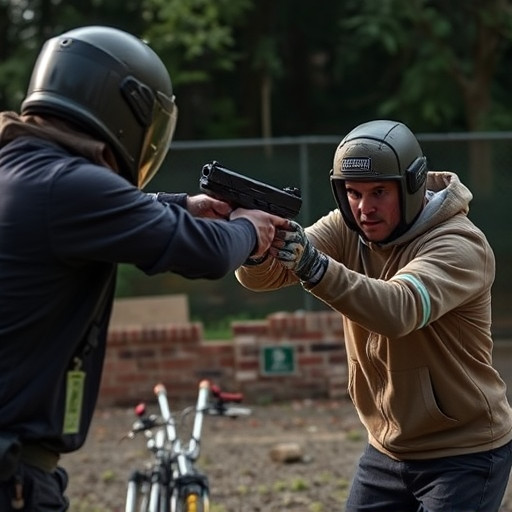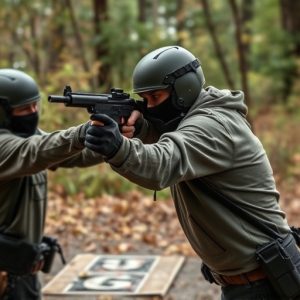Silent Stun Guns: Discreet Defense & Paralysis Duration After Taser Deployment
Silent stun guns (Tasers) offer a powerful tool for discreet self-defense and law enforcement, using…….
Silent stun guns (Tasers) offer a powerful tool for discreet self-defense and law enforcement, using electrical currents to temporarily paralyze targets. The duration of paralysis varies based on voltage, target's physical characteristics, electrode placement, and environmental conditions. Legal questions surround their use by civilians, with prolonged paralysis potentially necessitating additional justification. These compact devices provide crucial escape or help-seeking time in secluded or public spaces, minimizing risk of alerting assailants while empowering individuals to take control of their safety.
“In today’s world, understanding the impact of taser deployment is crucial for both law enforcement and individuals seeking discreet self-defense solutions. This article delves into the intriguing topic of paralysis duration after taser usage, exploring its immediate effects and underlying factors. We examine how various elements influence the time a person remains paralyzed and the legal implications surrounding self-defense rights. Additionally, we highlight the appeal of silent stun guns as effective yet subtle tools for personal safety.”
- Understanding Taser Deployment and Its Immediate Effects
- Factors Influencing Paralysis Duration
- Legal Considerations and Self-Defense Rights
- Choosing Silent Stun Guns for Personal Safety
Understanding Taser Deployment and Its Immediate Effects

Tasers, also known as electronic control devices (ECDs), are silent stun guns designed for discreet self-defense and law enforcement purposes. When deployed, they use electrical current to disrupt muscle control, causing temporary paralysis. The immediate effects of a Taser strike include muscle weakness, loss of balance, and disorientation, making it challenging for the targeted individual to move or resist effectively. This brief but powerful incapacitation provides officers with crucial time to secure or subdue individuals in potentially dangerous situations.
The duration of paralysis caused by a Taser can vary significantly based on factors like the model of the device, the number of probes deployed, and the target’s physical condition. Typically, the effects last for several seconds, during which time the individual is unable to stand or fight back. This short-term paralysis gives law enforcement officers a safe window to control and restrain the person without further escalation. Understanding these immediate impacts is vital for both public safety professionals and individuals considering silent stun guns for personal protection.
Factors Influencing Paralysis Duration

The duration of paralysis caused by a taser deployment can vary significantly, influenced by several factors. One crucial factor is the model and power output of the taser used. Different silent stun guns for discreet self-defense have varying voltage levels, with higher voltages typically resulting in longer durations of immobilization. The target’s physical condition also plays a role; individuals with lower body mass or certain medical conditions might experience shorter paralyses, as the current distribution can vary based on muscle mass and conductivity.
Another critical aspect is the placement of the electrodes on the body. Contacting vital areas like the neck, chest, or groin can lead to more prolonged paralyses due to the high concentration of nerves in these regions. The duration also depends on the duration of continuous contact between the electrodes and the target’s skin. Additionally, environmental factors such as temperature and humidity can impact the current flow, potentially affecting the perceived duration of paralysis.
Legal Considerations and Self-Defense Rights

When it comes to the legal implications of taser deployment, especially in scenarios involving self-defense, understanding the duration of paralysis is crucial. In many jurisdictions, law enforcement officers are permitted to use tasers as a less-lethal option for control and restraint. However, civilians carrying silent stun guns for discreet self-defense face distinct legal considerations. The duration of paralysis caused by a stun gun should be evaluated within the context of reasonableness and necessary force.
In self-defense situations, individuals have the right to protect themselves, but this right is balanced against potential overreaction or misuse. Legal experts argue that the time an individual remains paralyzed after a stun gun deployment can impact the perception of reasonable force. Prolonged paralysis may require additional justification, especially if it extends beyond what’s considered necessary to de-escalate a threat and ensure safety. Understanding these legal nuances is essential for those opting for discreet self-defense tools like silent stun guns.
Choosing Silent Stun Guns for Personal Safety

Choosing Silent Stun Guns for Discreet Self-Defense
In today’s world, personal safety is a top concern for many individuals, especially when facing potential threats in secluded or public spaces. Silent stun guns emerge as an innovative solution, offering discreet self-defense capabilities that can be easily carried and used without drawing unwanted attention. These devices utilize electric current to incapacitate an attacker temporarily, providing users with the crucial time needed to escape or seek help.
For those seeking a non-lethal way to protect themselves, silent stun guns are ideal. Their compact design enables easy concealment, making them accessible when needed while minimizing the risk of alerting assailants. This technology allows individuals to empower themselves without compromising their safety or facing the consequences of lethal force. With a focus on discreet self-defense, silent stun guns prove to be game-changers in personal security measures.
In conclusion, understanding the duration of paralysis after Taser deployment is crucial for both law enforcement and individuals considering silent stun guns for discreet self-defense. Several factors, including subject size, medical conditions, and environmental conditions, influence the length of this effect. By recognizing these variables, users can make informed decisions when choosing personal safety devices like silent stun guns. Additionally, legal considerations surrounding Taser use underscore the importance of understanding one’s rights and the potential consequences, ensuring responsible and lawful self-defense practices.


